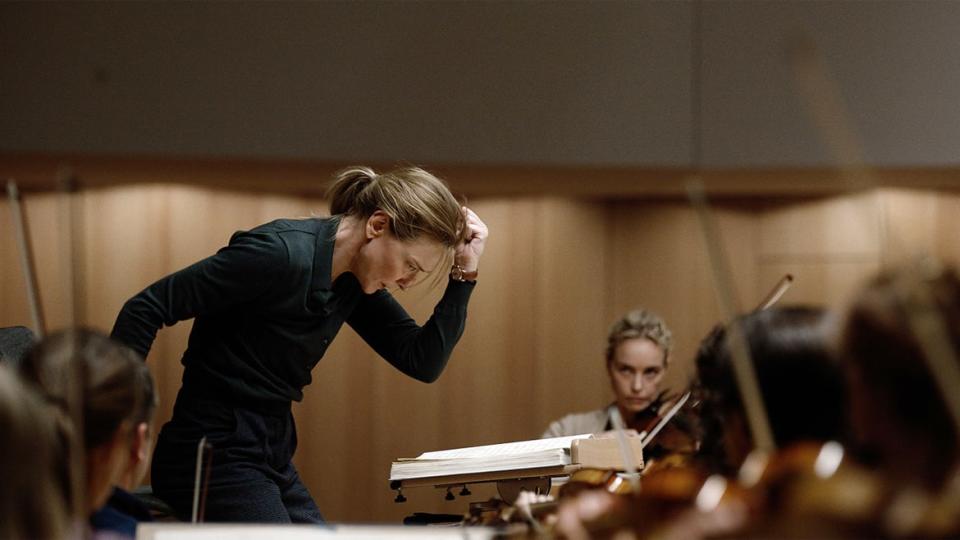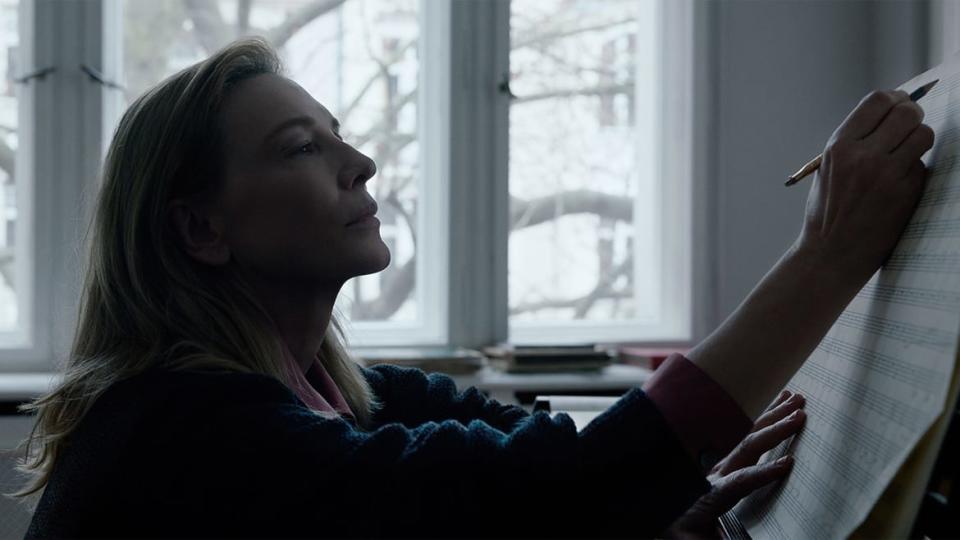The Masterful ‘Tár’ Would Be Nothing Without Nina Hoss

- Oops!Something went wrong.Please try again later.
- Oops!Something went wrong.Please try again later.
As Nina Hoss sinks into a plush hotel seat, porcelain teacup and saucer balanced in her hands as she speaks, it feels like we’re in a scene of Tár together. Here she is: Sharon Goodknow, the concertmaster of the Berlin Symphony Orchestra, participating in a press junket to chat about her wife, renowned conductor Lydia Tár (Cate Blanchett). Even the cloudy New York skyline participates, sprinkling the city with rain once every hour.
“It reminds me of Berlin,” Hoss chirps.
Somewhere in the city, the New Yorker’s Adam Gopnik is probably launching into some intellectual conversation as a part of this year’s New Yorker Festival, which is currently underway. It’s just like the opening scene of Todd Field’s Tár—Gopnik, playing himself, interviews Lydia about her upcoming recording of Mahler’s No. 5. The scene feels so true to life, one might feel the urge to Google search “Lydia Tár real story?” after seeing the film.
This is all to say: When Tár is at its most masterful (which, one could argue, is nearly every minute), the film transcends the theater and falls into the palms of our hands. Hoss feels this. She has been feeling this ever since she started working with Blanchett and Field. Now, the actress finally gets to gush about the film’s complexities with the rest of the world. To feel like we’re in Berlin together makes the whole experience even more immersive. Tár is a mere inch away from being real.
In ‘Tár,’ Cate Blanchett Is at the Peak of Her Powers as a Formidable Maestro
“You can’t stop talking about it!” Hoss tells me, unpacking several layers of Lydia’s character in our first two minutes together. “I ramble around, but that’s the amazing script that Todd already wrote, and this incredible interpretation from Cate, and from everyone, really.”
There is quite a bit to talk about, when it comes to Tár. Blanchett stars as a power-hungry (luckily, when we meet her, she’s satisfied with her enormous amounts of control, wielding the baton for one of the world’s best orchestras, boasting an EGOT, and about to drop an autobiography) orchestra conductor, with Hoss as her faithful wife and first violin, Sharon. Sharon is not, though, an “innocent particle in the system of Lydia Tár,” Hoss says.

Nina Hoss attends the red carpet of the movie Tár during the 79th Venice International Film Festival at the Palazzo del Casino in Lido of Venice, Italy, on Sept. 1, 2022.
“Who are we all around people that are geniuses, or special in a certain way?” she continues. “You lead an institution that has a certain system in itself, where people fall into that system and make their way through, that’s what they know. They want you to be a certain way, otherwise they won’t respect you. Do you actually have a chance to do things differently, even though everyone else demands it from you? Sharon is part of that.”
Lydia and Sharon do care for one another, but with their high ranks in the orchestra, their relationship hinges on being transactional. Just as much as they communicate through conversations, through dancing to Count Basie and raising their sweet daughter Petra, they must communicate through the baton’s swing. Plus, we’re meeting the couple right after the pandemic. Forced away from large groups of music-making individuals and secluded together with their daughter, this grand return to the stage may be too much for them to handle.
“To be able to get back and work on a Mahler symphony is so overpowering. It’s a lot,” Hoss says. “It’s maybe too much for this relationship. There are little cracks appearing because Lydia is in a place in her life where she’s not sure what’s next. She’s working on her legacy, but does that stop you being creative? Mahler the Fifth is the last piece of this box set. You have that there, out in the world, and then what? You’re on top of your craft, on top of the industry—there isn’t anywhere else to go.”
But Lydia can feel safe with Sharon. On top of the comfort of domestic life together, she seeks solace in the fact that her first violin is also her life partner and, hopefully, would follow her to the ends of the Earth. Still: “It’s not exactly what [Lydia] needs right now,” Hoss says. “She doesn’t need safe and calm.”

Cate Blanchett and Nina Hoss star in director Todd Field’s Tár.
The faults start appearing at the beginning of the film, but the earthquake hits towards the middle: Lydia is accused of grooming her fellowship students, particularly one, Krista Taylor, who recently took her own life. Anti-Tár protesters around New York City claim that this was possibly the result of Lydia’s behavior toward Krista. As their life begins to crumble, one might expect Sharon to bid a quick farewell to her wife. But she doesn’t. She stands by Lydia, pleading for more information. Instead of casting herself out of Lydia’s life, Sharon begs to be let back into it.
Because, just maybe, Sharon can be the first violin she was meant to be—someone who can make an entire orchestra believe in one sound, one conductor. She will be the perfect counterpart. If she can forecast the storm heading their way, she can contribute enough umbrellas to the orchestra, salvaging the work both she and Lydia have put into the music together. Still, Lydia pushes Sharon away even further, losing her orchestra in the process.
“[Cate and I] have a similar—without putting me on [her] level—way of approaching this job,” Hoss says. “The intensity she’s working with, and relentless search for every little detail in the character you’re portraying, really to the moment of pure exhaustion. On top of it, she’s the most lovely person. It made it very easy to dance together.”
Hoss actually played the violin in Tár, taking lessons from the Dresden Philharmonic Orchestra’s real first violinist—not just on how to play, but also on how to behave around the orchestra. Almost serving as an assistant to the conductor, the first violinist gives members of the team permission to leave earlier or grab some water, navigating their needs in a cool and friendly way so that the conductor doesn’t have to.
“That informed a lot of Sharon,” Hoss explains. “I thought, ‘That’s exactly what Sharon needs to be in a position to Lydia.’ This genius might be a bit harsh to these musicians—it’s a slap to the face. It’s Sharon’s job to calm them down.”
In real life, one might never see an orchestra led by a woman first violinist and conductor, but that’s part of the appeal of Tár. They’re just there. No questions asked. It’s not a big feminist statement, and yet, the fact that it’s not a big feminist statement is a statement in and of itself: “This film presents it as a normal thing,” she says. “That’s just the way it is. Two women have the two most powerful positions in the orchestra.”

Cate Blanchett as Lydia Tár.
The Tár team rehearsed and shot with the Dresden Philharmonic Orchestra, playing alongside real musicians and real music, which only added to Hoss’ ability to get into character.
“What you get to experience in this body of an orchestra is that all these individuals, they come together, they take their instruments out of their cases, they put it on their chair, and then, all of a sudden, concentration,” she says. “You hear a sound, and you think, “What just happened?” It’s like the sky opens. This is what you get to do every day? That’s so beautiful. I knew this is what Sharon is in for, this is what Lydia is working to do.”
Adding onto that brilliance, Hoss says, is the fact that Blanchett is nearly prepared to lead an orchestra in the real world: “Oh,” she gasps, wide-eyed, after I ask her if it’s a possibility that Blanchett could embrace her inner Lydia off-screen. “If she puts the time and effort behind it, I would think so.”
In Tár, Blanchett does all her stunts too. Kind of. She learned to conduct, play the piano, and speak German for the film, all in order to fully embody Lydia. In one scene, Lydia and Sharon argue in the car over an assistant quitting, Lydia swerving all over the place in a roundabout until another driver nearly hits them. Sharon demands Lydia to slow down, or to be let out of the car. Lydia obliges—she halts the car and opens the door for her wife to walk home.
Normally, stunt actors or VFX teams would have handled this scene. But Blanchett worked with other stunt drivers, choreographing the scene and practicing the hell out of it so that she, herself, could be at the wheel, Mission: Impossible-style.
‘TÁR’ Earns Every Last Second of its 168-Minute Runtime
“She’s a hell of a driver, on top of all the talent that she has, so I felt super safe,” Hoss says. “It was choreographed so the moment that you saw the car right in front of Sharon—she wasn’t just driving around like a crazy woman. But she went for it, so I didn’t have to act much!”
There is, however, a more violent scene towards the end, one that likely required stunt work. (In the credits, only two actors have stunt doubles: Blanchett and Mark Strong, who plays Elliot.) After Lydia has been booted from the Berlin podium, her hungry investor Elliot takes over, readying her Mahler scripts to conduct on his own terms. Raging, Lydia stampedes onto stage and pummels Elliott off the podium in front of a live audience.

Cate Blanchett as Lydia Tár.
Sharon could gasp at her wife. She could look at her disapprovingly. But that would be too obvious. Instead, she appears to be unscathed, interested in Lydia’s actions more than she is shocked.
“I hope you can see that I find her very fascinating,” Hoss says, of her final look at the broken-down Lydia. “This is the attraction of being around people that are so passionate and so gifted that they go further than you, yourself, would, or Sharon would allow herself to go.”
Reviews for Tár have been overwhelmingly positive—this publication’s included—with early awards speculation for both Blanchett and Hoss. While Hoss has allowed herself to celebrate a bit (especially with Cate, as the two sport identical outfits and screw around on red carpets together), she’s still hesitant to label the masterful film as a triumph just yet. Tár opened in New York and Los Angeles on Oct. 7 and expands to a wider audience this coming weekend. Hoss hopes the exhilaration won’t fizzle out as the rest of the country tunes in.
“That happened with Nomadland. It had such a buzz. People were disappointed. You wonder what it is, but then it’s not what you expect,” Hoss says—though Nomadland still went on to win Best Picture at the Oscars. “Also, there’s not a plot [to Tár], or a pivotal moment where then on, everything happens. It’s this zen thing, the path, the goal.”
Coming in at nearly three hours, Tár certainly isn’t a short film. But similar to finishing a long book, watching Field’s film all the way through feels like completing a journey, or taking part in an experience. Tár is an event to discuss with friends, to argue about, to gossip over, to quote lines, to root for in awards season, to pick apart like a science experiment.
“I hope, also, that they go to the cinema,” Hoss says of the ideal way to see the film. “You just sink into her life for two-and-a-half hours, and think about all these questions that are being raised that surround us in a big way. It’s thought-provoking.”
As I exit the hotel, I’m half-expecting to run into Lydia Tár herself in the streets of New York, hiding under a giant umbrella with her Mahler score in hand. I don’t. But a few days later, I find myself seeing Tár a second time, sinking into Lydia’s life through Sharon’s eyes, delving into the film’s complexities from a new perspective. It’s something you can—and should—do over and over again: find a new lens from which to watch Tár, and unpack its brilliance on repeat until you, yourself, can conduct Mahler’s Fifth Symphony.
Get the Daily Beast's biggest scoops and scandals delivered right to your inbox. Sign up now.
Stay informed and gain unlimited access to the Daily Beast's unmatched reporting. Subscribe now.

